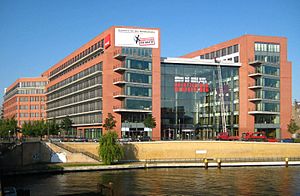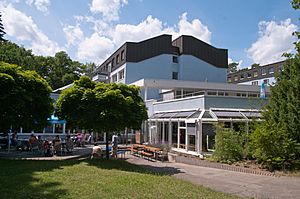- This page was last modified on 17 October 2025, at 10:18. Suggest an edit.
ver.di facts for kids
|
Vereinte Dienstleistungsgewerkschaft - ver.di
|
|
 |
|
| Founded | 19 March 2001 |
|---|---|
| Headquarters | Berlin, Germany |
| Location |
|
|
Members
|
1.9 million |
|
Key people
|
Frank Werneke, president |
| Website | www.verdi.de |

Verdi headquarters in Berlin-Mitte
Vereinte Dienstleistungsgewerkschaft (Verdi, pronounced "ver-dee") is a large trade union in Germany. It means "United Services Trade Union" in English. Verdi is based in Berlin, Germany.
It started on March 19, 2001. This happened when five different unions joined together. Verdi is part of the German Trade Union Confederation (DGB). It is the second largest trade union in Germany. It has about 1.9 million members. Verdi helps its members with their jobs and working conditions.
Contents
How Verdi Started
Verdi was formed in March 2001. Five different unions decided to merge. A merger is when two or more organizations combine to become one.
These unions were:
- German Salaried Employees' Union (DAG)
- German Postal Union (DPG)
- Trade, Banking and Insurance Union (HBV)
- Media Union (IG Medien)
- Public Services, Transport and Traffic Union (ÖTV)
The oldest union that became part of Verdi was the Association of German Printers. It was founded way back in 1866.
Leaders from these unions started talking about working together in the 1990s. They wanted to create a stronger voice for workers. In 1997, they signed an agreement called the "Hamburg Declaration." This agreement showed they wanted to create a new, big union for people working in service jobs.
In 1999, the leaders of the five unions agreed to merge. They opened an office in Berlin. Delegates from each union voted to create a temporary organization. This was a step towards forming Verdi.
The people involved thought this merger was a big deal. They believed it would stop unions from competing with each other. In November 2000, the unions voted to establish Verdi. The final step happened in March 2001. The five unions officially dissolved themselves. Then, the founding congress of Verdi took place. This is where the new union was officially created.
Soon after, Verdi signed its first important agreement with Deutsche Lufthansa. Verdi was also accepted into the DGB.
How Verdi is Organized
Verdi has a clear structure to help its members. Its highest decision-making body is the National Congress. This meeting happens every four years. It sets the main goals for the union. It also elects the leaders of the National Executive Board and the Trade Union Council.
Verdi is organized into different levels and groups. These groups help represent the interests of different professions. This system is called a matrix system. It helps the union represent everyone. Verdi also makes sure that men and women are treated equally in all parts of the organization.
The Trade Union Council and National Executive Board
Between the big National Congress meetings, the Trade Union Council is the highest body. It has representatives from different regions and groups. The council makes sure Verdi follows its rules. It also approves the union's money plans. It supervises the National Executive Board.
The National Executive Board runs Verdi's daily business. It represents the union inside and outside the organization. The Board includes a chairman, managers for different divisions, and other members. Currently, there are nine members on the Board.
Regional Structure
Verdi has regional offices across Germany. The smallest units are local districts. These help members in specific areas work together. Above these are larger districts. These districts are part of ten federal state districts.
Verdi currently has ten federal state districts:
- Baden-Württemberg
- Bavaria
- Berlin-Brandenburg
- Hamburg
- Hesse
- Lower Saxony / Bremen
- North (Schleswig-Holstein, Mecklenburg-West Pomerania)
- North Rhine-Westphalia
- Rhineland-Palatinate / Saarland
- Saxony, Saxony-Anhalt and Thuringia
Divisions and Member Groups
Verdi's divisions focus on different industries and job types. They work to support the specific interests of members in those areas.
Verdi currently has five main divisions:
- A: Financial Services, Communications and Technology, Culture, Utilities and Disposal
- B: Public and Private Services, Social Insurance and Traffic
- C: Health, Social Services, Education and Science
- D: Trade
- E: Postal Services, Shipping Companies and Logistics
Within these divisions, there are also special groups. These groups help specific professions.
Verdi also has "groups of individuals." These groups represent members with shared interests.
There are eight groups of individuals:
- Young People
- Senior Citizens
- Workers
- Civil Servants
- Masters, Technicians and Engineers
- Freelance Collaborators and Personally Self-Employed, Freelance or Employee-Like Individuals
- Unemployed Individuals
- Migrants
These groups have their own rules and goals.
Membership Numbers
Verdi's total number of members has changed over time. In 2001, it had 2.81 million members. By 2014, this number was 2.04 million. Some members left to join other unions. Verdi works hard to get new members and keep them.
Since 2008, Verdi has had a special online network for its members. This network helps members connect. They can share ideas and get information. It also has a platform for union committees and active members.
What Verdi Does
Helping Workers with Agreements
Verdi works to improve working conditions for employees. It does this through "collective agreements." These are agreements between unions and employers about pay, hours, and other job rules. Verdi believes these agreements help workers have a stronger voice.
Verdi also works to make sure men and women are treated equally at work. It also tries to make wages and pensions fair across all parts of Germany.
Verdi is well-known for its actions in public service jobs. For example, in 2006, Verdi members went on strike for three months. They were fighting for a new collective agreement. In 2008, after more strikes and talks, Verdi reached a new agreement. This agreement increased wages for many public service workers.
In 2015, Verdi held strikes at Deutsche Post. This was about pay and plans for a new parcel delivery section. These strikes cost the company a lot of money.
In 2023, Verdi organized a strike for security staff at major German airports. This caused flights to be cancelled in cities like Berlin, Bremen, and Hamburg.
Educational Programs
Verdi runs several educational centers across Germany. These centers help members learn new skills. They also help members share their experiences. These programs are especially helpful for people on works councils. They offer training on job-related topics and general education.
Verdi has educational centers in many cities. These include Berlin, Bielefeld, Brannenburg, Gladenbach, Mosbach, Naumburg (Hesse), Saalfeld, Undeloh and Walsrode.
Verdi also has a special educational organization called ver.di Bildung + Beratung (ver.di b+b). This group offers seminars for different worker groups. It also publishes guidebooks and legal commentaries. Its main office is in Düsseldorf.
International Connections
Verdi is part of many international union groups. These groups help unions work together across different countries. Some of these include the UNI Global Union, the International Transport Workers' Federation, and the Public Services International. Verdi also works with European trade union groups.
Presidents
- 2001: Frank Bsirske
- 2019: Frank Werneke
See also
 In Spanish: Ver.di para niños
In Spanish: Ver.di para niños

